
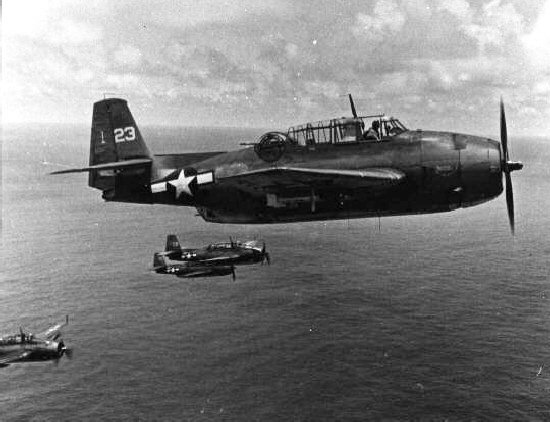
TBM Avengers |

An FM-2 Wildcat |
|---|
As a "composite squadron", VC-27 operated both FM-2 Wildcat fighters and TBM-1C Avenger torpedo-bombers. The FM-2s flew CAP (Combat Air Patrol) to protect the fleet and attacked both ground and sea targets. The Avengers attacked sea targets using torpedoes, bombs, rockets and 50 caliber ammunition and ground targets using bombs, rockets and 50 caliber ammunition.
By pure happenstance, both aircraft were Grumman aircraft built by the Eastern Aircraft Division of General Motors. For this reason, they are sometimes referred to as "Eastern Aircraft" or "General Motors" aircraft.
| FM-2 Wildcat | TBM Avenger | A6M Zero | ||
|---|---|---|---|---|
| Wingspan | 38' 00" | 54' 02" | 39' 04" | |
| Length | 28' 09" | 40' 11" | 29' 09" | |
| Height | 11' 05" | 15' 05" | 10' 00" | |
| Takeoff Weight | 8,221 lbs | 17,893 lbs | 5,313 lbs | |
| Horsepower | 1,350 hp | 1,900 hp | 950 hp | |
| Speed | 322 mph | 276 mph | 331 mph | |
| Range | 1,350 miles | 1,000 miles | 1,929 miles | |
| Service Ceiling | 35,600' | 30,100' | 33,000' | |
| Armament | 4 x 50 cal | 4 x 50 cal | 2 x 7.7mm | |
| 2 x 20 mm | ||||
| Bombs | N/A | 2 x 500 lbs |
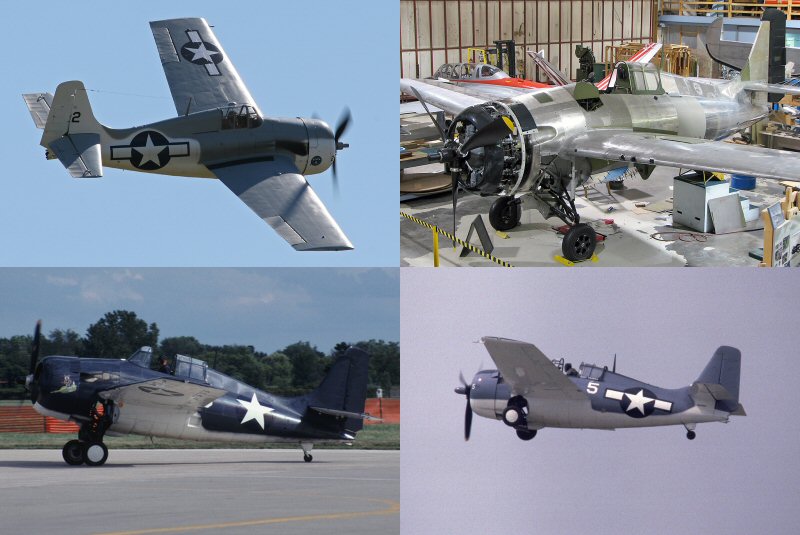 A sampling of FM-2 pictures available on airliners.net.
Note that in the lower right picture, the pilot is bent over cranking up his
landing gear by hand - one of the "features" of the Wildcat.
A sampling of FM-2 pictures available on airliners.net.
Note that in the lower right picture, the pilot is bent over cranking up his
landing gear by hand - one of the "features" of the Wildcat.
The General Motors FM-2 Wildcat was a lightweight and more powerful version of the Grumman F4F Wildcat.
The F4F Wildcat was originally designed in the 1930s as an all-metal biplane with retractable landing gear. Although it was a nimble fighter, it was not quite able to keep up with the Zero. It was heavier and did not climb as fast (although it was faster in a dive). By mid-war, the F4F was phased out in favor of more powerful aircraft such as the F6F Hellcat and the F4U Corsair. However, when Naval planners needed a lightweight fighter to operate from the decks of Escort Carriers, they decided to upgrade the F4F.
The FM-2 differed from the F4F in a number of ways. The FM-2 had a lighter, yet more powerful Wright R-1820 radial engine. The plane carried four rather than six .50 caliber machine guns and was often fitted with HVARs (High-Velocity Aircraft Rockets) for use against ground targets, ships or surfaced submarines. The FM-2 also had a larger tail than the standard F4F to counter the increased torque produced by the Wright engine.
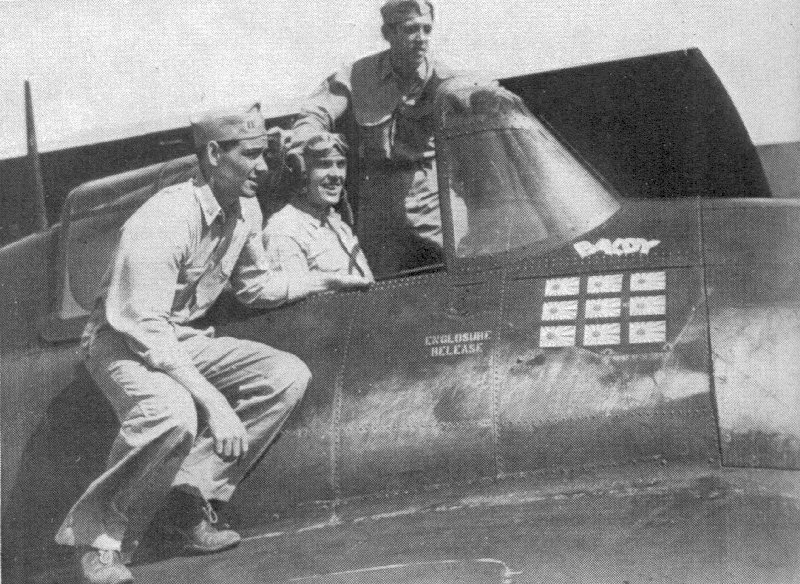 The VC-27 FM-2 flown by Lt Ralph Elliott showing his 9 kills.
The VC-27 FM-2 flown by Lt Ralph Elliott showing his 9 kills.
These changes increased the climb rate and made the FM-2 capable of dog-fighting with all Japanese aircraft. It was quite similar in size and performance to Zero fighter. The FM-2 weighed more, partly because the Zero did not have self-sealing tanks or significant armor plating, making the Zero very vulnerable to machine gun fire.
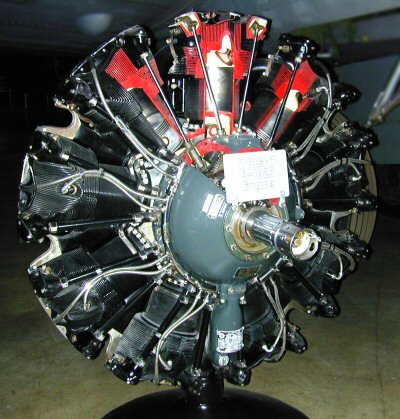
Wikipedia, USAF Museum, Dayton, OH. |
The FM-2 Wildcat was powered by the Wright R-1820-56W "Cyclone 9" which was a 1350hp single-row 9-cylnder radial engine. In contrast, the F4F Wildcat was powered by the heavier and less powerful Pratt & Whitney R-1830-86 "Twin Wasp", which was a 1200hp dual row 14-cylinder radial engine. The Cyclone 9 was also used in the B-17 bomber and the Sherman tank. The engine was started with a shotgun shell (minus the shot, of course). The higher torque and power gave the plane a pronounced tendency to veer off to the left during takeoff. To avoid heading off into the weeds (or, on a carrier, the ocean), the pilot had to remember to set the trim tab two marks to the right and had to press hard on the right rudder during takeoff. |
|---|
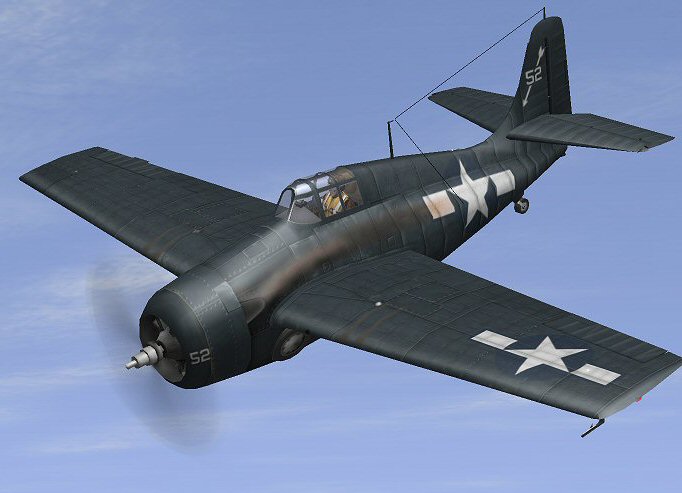 This picture depicts an FM-2 Wildcat in VC-27 markings.
This picture depicts an FM-2 Wildcat in VC-27 markings.
Navy aircraft used several different paint-schemes - including 3 tone, 2 tone and 1 tone. Each squadron also had different markings. The above picture appears to show the correct markings for VC-27. However, veterans of VC-27 advise that the squadron used a 2 tone paint scheme, with light gray on the bottom.
 The FM-2 instrument panel showing typical WWII instruments and typical arrangement.
The FM-2 instrument panel showing typical WWII instruments and typical arrangement.
.jpg)
Like most Navy planes, the FM-2 used a Mark 8 reflector gunsight. The pilot looked through a circular pane of glass. When turned on, a lamp projected a gunsight image on the glass. One advantage was that the image was focused "at infinity" so that the gunsight image remained sharp when the pilot focused on the target. A version of this gunsight was also used on the F4U Corsair and the P-47 Thunderbolt.
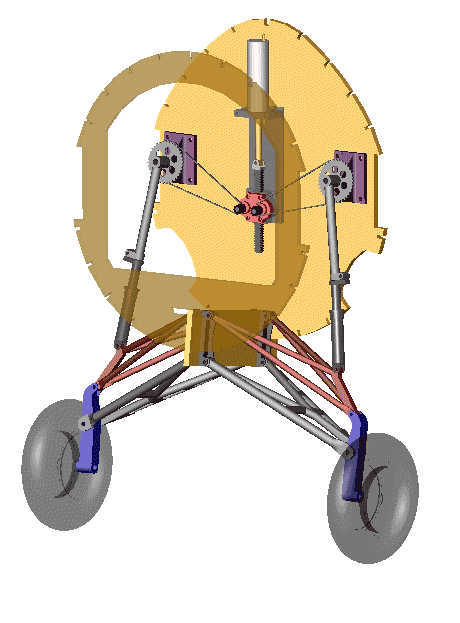 |
 |
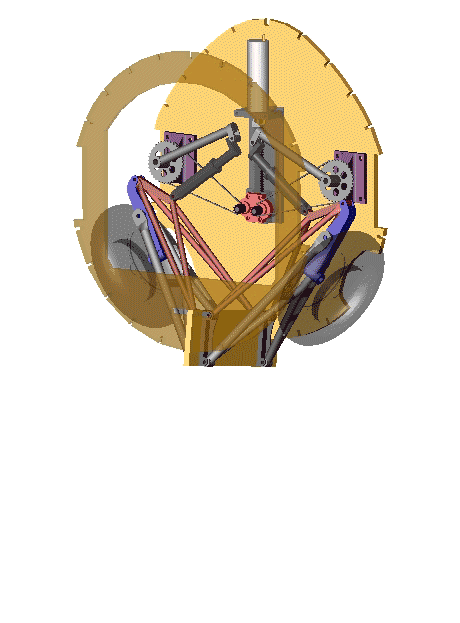 |
The landing gear on the Wildcat was an odd mechanism. Unlike most aircraft, which had a single strut, the gear on the Wildcat was a "Rube Goldberg" contraption that drew the wheels into the fuselage. Furthermore, the gear was not motorized. The pilot had to crank the gear up and down by hand using a crank on his right side. This meant that the pilot had to take his left hand off the throttle (hoping that he had secured the friction lock), so that he could fly the plane with his left hand and crank with his right hand - 31 times. This led to pilot-induced wobbling immediately after takeoff and before landing.
|
Excerpt from "Memories of My Visit to Ponam Island" - Recollections of Bill Peden: "From time to time it was interesting for the torpedo pilots to listen to a group of fighter pilots discuss ways and means to look HOT when flying those FM2's. Looking HOT from a fighter pilots perspective was to perform a feat that would distinguish that pilot from all others. So here is the result of one of those fighter pilots confabs. "On take off (from a runway, not a carrier) raise the tail wheel so that the fuselage is parallel to the runway. When one reaches flying speed, flip the wheel lock and raise the landing gear. This was not manually in the FM2 with a hand crank in the cockpit. While cranking the gear hold the plane so that it does not gain or lose altitude and there you have one HOT looking takeoff. OK, so the first pilot to try this comes roaring down the runway, raises the tail in the prescribed manner, flips the wheel lock and starts cranking the landing gear. With each turn of the handle the plane goes lower and the propeller grinds into the runway and you can imagine the rest. In a shower of coral and sparks our HOT pilot has all but demolished on FM2. As it comes to rest, he jumps out of the cockpit and runs away to avoid a possible fire. Again, we won't elucidate on the aftermath." |
|---|
The landing gear also had a narrow wheelbase (the distance between the front wheels), which led to an increased tendency to "ground loop" on landing.
Note: Tail-draggers are prone to ground looping because the center of gravity is behind the main wheels. As the plane slows down, the back end wants to keep going. Once the tail starts breaking around, the plane is likely to pirouette several times around the main gear until the plane comes to an embarrassing stop. The pilots could help avoid this by locking the tail wheel in the forward (rather than fully-swiveling) position. However, they sometimes forgot.
Of course, ground-looping would not be a problem on a carrier landing - as long as the hook caught the wire - since the wire would be holding the tail back.
Although the F4F Wildcat and the FM-2 looked alike, the FM-2 was able to hold it's own in a turning fight with a Japanese Zero (Zeke). Many Japanese pilots learned this the hard way.
|
Excerpt from "Combat Evaluation of Zeke 52 with F4U-1D, F6F-5, and FM-2", TAIC Report No. 17 dated Nov 1944:
C. ZEKE 52 vs FM-2
CLIMB |
|---|
Oddly, after conceding that the "remarkable" maneuverability of the Zeke was only slightly better than the FM-2, the report suggests that the FM-2 not dogfight with the Zeke. This recommendation was probably ignored by the men of VC-27.
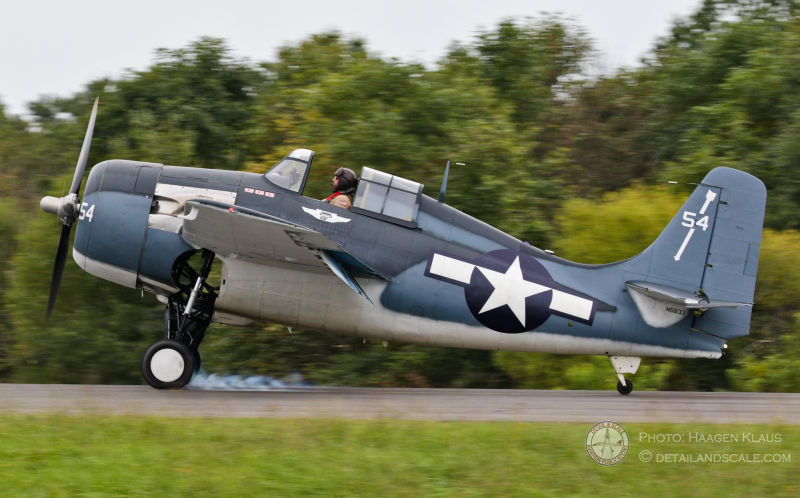 Here is a photo of Chris Schaich landing the CAF FM2.
As the little puff of smoke shows, this was a perfect landing for this old and valuable plane.
Here is a photo of Chris Schaich landing the CAF FM2.
As the little puff of smoke shows, this was a perfect landing for this old and valuable plane.
The Commemorative Air Force is currently operating an FM-2 which is painted in VC-27 markings. Here is an animation of the aircraft in flight.
The TBM typically carried a crew of only 3 - the pilot, the gunner and the radioman/gunner. The space behind the pilot was generally empty.
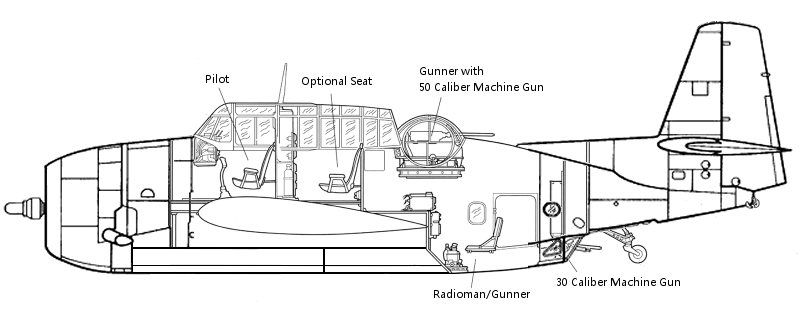
The TBM typically carried a crew of only 3 - the pilot, the gunner and the radioman/gunner. The space behind the pilot was generally empty. However, on occasion, they carried an additional passenger, such as an artillery spotter.
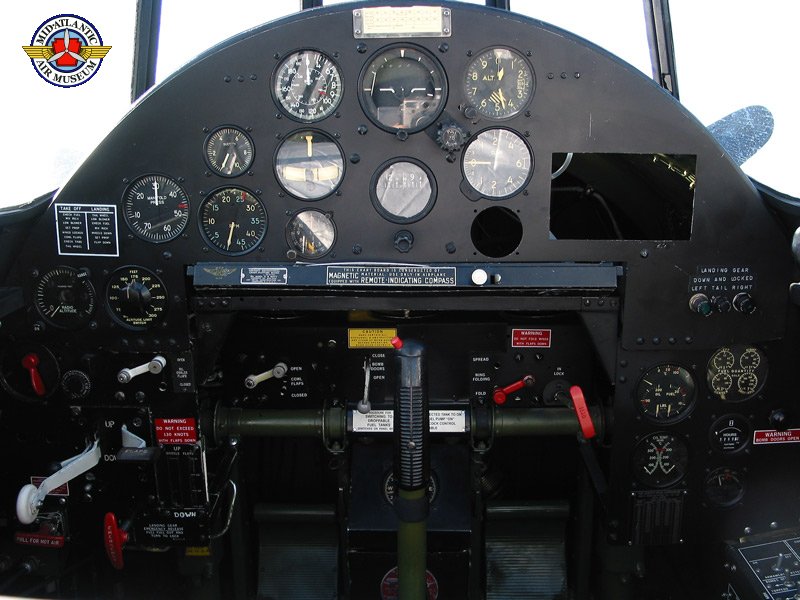 The instrument panel of the restored TBM at the Mid-Atlantic Air Museum.
In accordance with modern practice, the attitude indicator is the primary instrument at center top.
The instrument panel of the restored TBM at the Mid-Atlantic Air Museum.
In accordance with modern practice, the attitude indicator is the primary instrument at center top.
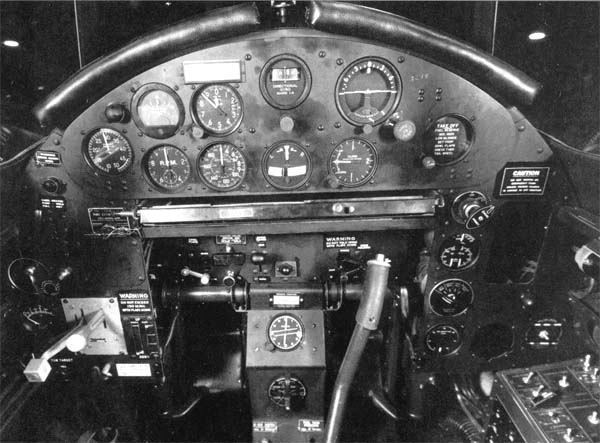 The same panel in WWII. Note the difference in instruments and their arrangement.
In those days, the primary instruments were "needle, ball and airspeed".
The needle and ball are in the center, below the compass - which was important for long over-water navigation.
The same panel in WWII. Note the difference in instruments and their arrangement.
In those days, the primary instruments were "needle, ball and airspeed".
The needle and ball are in the center, below the compass - which was important for long over-water navigation.
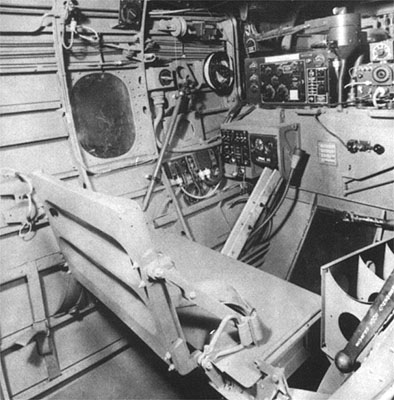
The radioman/gunner sat in the "bilge".
|

The seat folded up for access to the rear gun and exit.
|
|---|
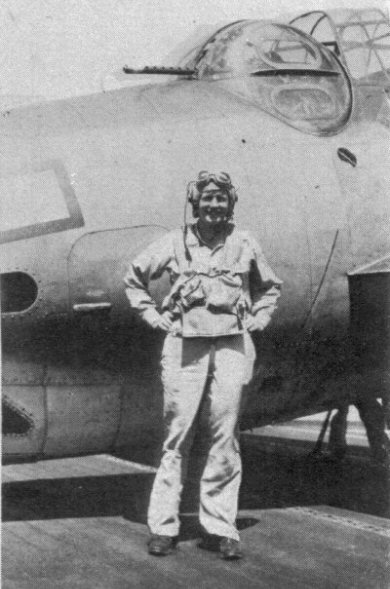
A VC-27 TBM pilot ready to climb aboard.
(Note the crew hatch behind him to the area where the radioman sat.)
Also note that the plane appears to be a lighter shade of blue than others in the squadron.
(See the pictures of the planes taking off on the Mission page.)
|
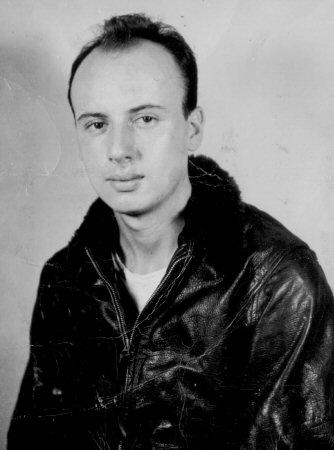
ARM 3/c William Patrick Simmons, pictured here in his flight jacket, was a typical radioman-gunner.
He flew 29 combat missions with VC-27.
|
|---|